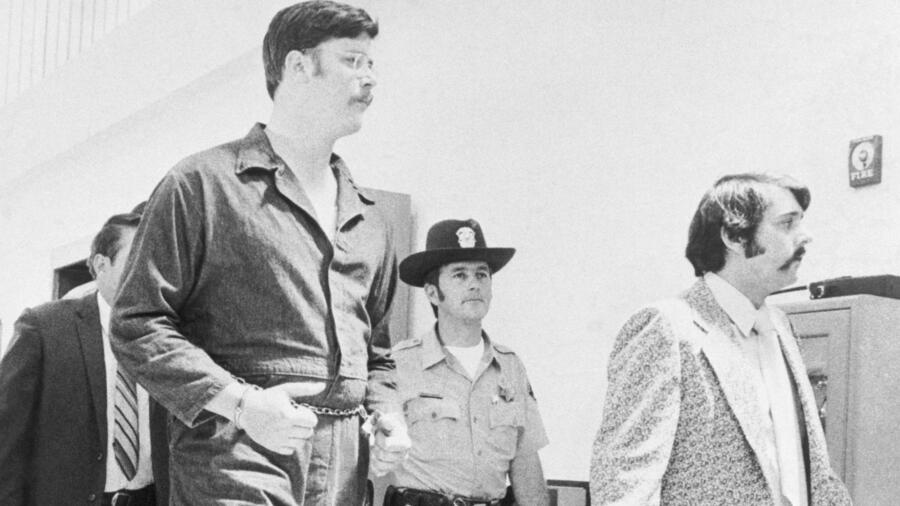Warning: The following contains disturbing descriptions of violence, including sexual violence. Reader discretion is advised.
After serial killer Edmund “Ed” Kemper murdered his first victims—his grandparents—at age 15 in 1964, he was confined to Atascadero State Hospital, one of the largest forensic mental health facilities in the world.
Kemper was released on parole on his 21st birthday. He flew under the radar for a couple of years, at one point even applying to be a state trooper—but being rejected because, at 6 feet 9 inches and 300 pounds, he was too big. Then, he went on an 11-month killing spree targeting women.
Between May 1972 and April 1973, Kemper butchered five college students, a high school student, his mother and her best friend. He raped his first victim, had sexual intercourse with the bodies of his next five victims, and had sex with his mother’s head.
He severed the heads of all his victims except that of his mother’s best friend, whom he strangled April 20, 1973 to support a made-up story that she and his mother had gone away on vacation together.
Kemper, who became known as the “Co-Ed Killer,” was arrested four days later, after he drove to Pueblo, Colorado, and called the police from a phone booth to confess.
[Stream an episode of A&E’s First Blood, on Ed Kemper and his victims in the A&E App.]
A jury found him guilty of eight counts of first-degree murder on November 8, 1973.
So how did Kemper manage to get released on parole after shooting his grandparents in the back of their heads with a rifle?
According to Dr. Alfred Rucci, the hospital’s acting director at the time, it was because there are no certainties in psychiatry when it comes to predicting murder and violence by people who are considered criminally insane. “Most of this work is a matter of an educated guess,” Rucci told the Los Angeles Times in May 1973.
Modern experts who’ve studied Kemper’s horrifying crimes have different viewpoints.
Early Signs In Kemper’s Childhood
Kemper was born in California and moved at age 9 to Montana with his mother and sisters after his parents divorced. His mother yelled and screamed at him, smacked him on the head and made him sleep in a small bed in the basement, author Dary Matera writes in his book, Ed Kemper: Conversations with a Killer.
According to the book, Kemper began fantasizing about killing his mother at a young age. He developed a fascination with beheading—first his sisters’ dolls and eventually the family cats. At age 10, he buried one of the cats, dug it up after it asphyxiated and cut off its head. Three years later, he cut off the head of another cat and displayed it on a platter.
His mother later justified making her son sleep in the basement to keep her daughters safe, sensing he might try to molest them, the book says.
People shouldn’t draw a direct line between Kemper’s childhood and his later crimes, Matera tells A&E True Crime.
“Initially when I heard about him being banished to the basement to sleep, in some accounts it was painted as a horror story, like he was tortured,” Matera says. “But the more I researched it, the more I saw it was a place for him to stay. It was unpleasant, and it was dark and scary, but it wasn’t horrific in that it will make you a serial killer.”
At age 15, Kemper left Montana and tried to go live with his father in Los Angeles, California. However, his stepmother didn’t tolerate his presence, so he was sent to live with his grandparents on their farm in the foothills of California’s Sierra Nevada mountain range.
His grandmother “kept a tight rein” on Kemper, preventing him from going into town to hang out with his peers, Matera writes. As for his grandfather, Kemper viewed him as senile.
Isolated and increasingly angry, Kemper—who’d killed birds and small animals on the farm—slayed his grandparents after yet another fight with his grandmother.
“I just wanted to see what it felt like to kill grandma,” he reportedly told police.
Diagnosed with paranoid schizophrenia, Kemper was sent to Atascadero. There, he used his charm and intellect—he reportedly had an IQ of 145—as well as what he learned from fellow criminal residents to deceive the mental health professionals into thinking he was cured, Matera says.
“It was basic survival—learning how to game the system,” he says.” [The residents] would go to group therapy and they would all play nice and say they were all sorry for what they did. Then when the doctor goes home, they are all telling each other stories of how they enjoyed hacking up women and raping them.”
From his fellow criminals, Kemper also learned what mistakes to avoid, like not targeting women he knew and murdering only in places where he didn’t hang out, Matera says.
“His time [at Atascadero] turned him into more of a killing machine.”
Prison Would Have Been Better
Kemper never should have been sent to Atascadero—instead, he should he been imprisoned, Louis B. Schlesinger, a professor of psychology at John Jay College of Criminal Justice, tells A&E True Crime.
But Kemper’s obsession with sex and death at an early age, which then drove him to sexually motivated killings, “was not on the radar screen for any mental health professionals back in 1964,” Schlesinger says.
Kemper was drawn to compulsive murder because it was sexually gratifying to him, Schlesinger says. “That’s an extremely dangerous and deviant and rare disorder,” he says.
Instead, Kemper was diagnosed with paranoid schizophrenia, a very common diagnosis for those deemed criminally insane back in the 1960s, Schlesinger says. “But he wasn’t a paranoid schizophrenic. He wasn’t delusional. He didn’t have hallucinations.”
Instead, Kemper was bright and likeable. Eventually, those who treated him simply deemed he’d been there long enough, Schlesinger says.
“If you’re a mental health professional, you want to cure patients,” he says. “I don’t mean this in a critical way, but everybody wants to believe their patients are cured. They just didn’t see the signs.”
According to Ed Kemper: Conversations with a Killer, Kemper liked to brag that he bested the professionals, even claiming he once kept the severed head of a victim in the trunk of his car while visiting one of their offices. Schlesinger says he doesn’t believe that account. “That [story] is only coming from Kemper, and these guys don’t tell the truth.”
“A lot of people say he fooled [the mental health professionals],” Schlesinger adds. “It’s not really that he fooled them. It’s that he shouldn’t have been there in the first place. He should have been in prison.”
So would Kemper have been sent to prison if he’d killed his grandparents today?
“It’s very, very hard to say,” Schlesinger says, “but certainly mental health professionals are a lot more focused now on these sexually aggressive problems, way more than in the mid-1960s.”
Where Is Ed Kemper Today?
Kemper is currently imprisoned at the California Medical Facility in Vacaville. He has been denied parole over the years, the last time in 2017. Shortly after, his brother told the Daily Mail that his family had been living in fear that he might be released from prison and come after them.
Kemper will be eligible for parole again in 2024.
Related Features:
Ann Wolbert Burgess on Learning from Serial Killers While Working With ‘Mindhunters’
Edmund Kemper: Why Would a Serial Killer Help the FBI Understand Other Serial Killers?


